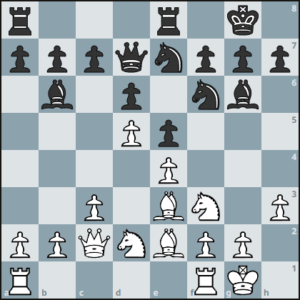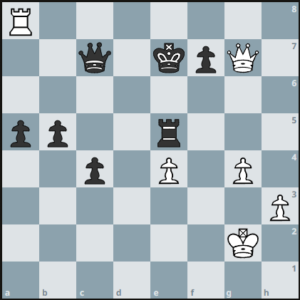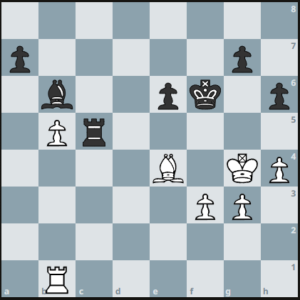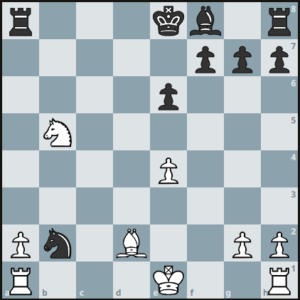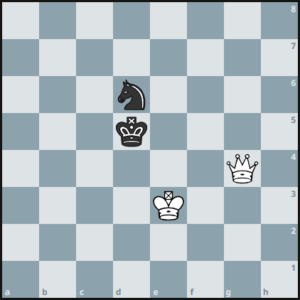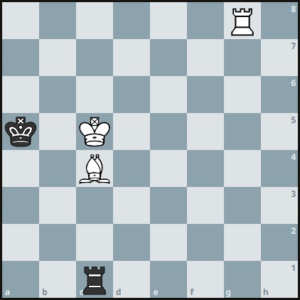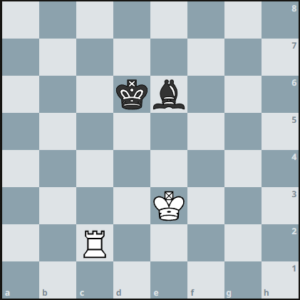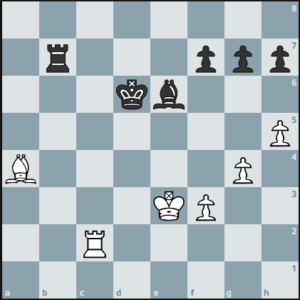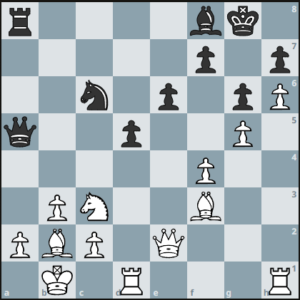Here are some photos of me taken at The American Cup 2023 where I was the Chief Arbiter. Photos courtesy of the Saint Louis Chess Club Flickr Photo Site, taken by Lennart Ootes, Bryan Adams, Crystal Fuller and Austin Fuller.
All posts by Chris Bird
2022 US Chess Rules Refresher Quiz
This quiz is based on the US Chess Rules effective January 1, 2022, and was accurate at the time of publishing. Answer all questions per the 2022 US Chess Rules, and where applicable, assume you are the US Chess Tournament Director overseeing a US Chess rated game/event.
Photos – The American Cup 2022
The American Cup – Beware the Spicy Salmon Rolls!
GM Levon Aronian is not only one of the best chess players in the world, but one of the nicest ones too. No matter good or bad things are going at the chessboard, he always has a smile on his face and a cheery disposition. He’s also known for being a sharp dresser, especially his bright and colorful shirts!
On day 3 at The American Cup, he lost with the white pieces to GM Leinier Dominguez in game 1 of his Championship Bracket match and so today (day 4), he needs to win with the black pieces to take the match to a playoff. Of course with this format, the bright side is that even if he doesn’t get a result, he’ll head to the Elimination Bracket and still retain chances to win the event.
A couple of minutes into the start of his game, he was in the Boardroom, an area where the Saint Louis Chess Club provides the players with a veritable feast of delicious snacks and drinks to see them through the day. When players enter this area, one of the arbiters usually follows, and in this case it was me.
Looking at me seriously, Levon whispers “what is the difference between the regular salmon rolls and the spicy salmon rolls?” Thinking this was a serious question (I should have known better), I responded “the spicy ones are spicy?”
“No” says Levon, “the spicy salmon rolls are older.” A rue smile then crosses his face as he continues with the punchline, “yesterday we had salmon rolls, today we have spicy salmon rolls!” and he chuckles as he heads back into the main playing hall.
Ugh… got me!
The American Cup – Round 1 Armageddon
The American Cup is now a couple of days in and today we had our first taste of the playoffs, including one match that went all the way to Armageddon between GM Fabiano Caruana and GM Jeffery Xiong.
The following tweet was posted by the Saint Louis Chess Club and sort of explains what happened at the end of the game. Remember the time control for the Armageddon games is 5-minutes for White, 4-minutes for Black, with a 2-second increment in effect after move 60.
Check out the dramatic final moments in the Armageddon game between GM Fabiano Caruana & GM Jeffery Xiong – #TheAmericanCup https://t.co/8IHb6krijC pic.twitter.com/BOajAqJksP
— Saint Louis Chess Club (@STLChessClub) April 22, 2022
There are two moves in the PGN that were not really part of the game, 60… Kc3 and 61. Kg2, because Xiong “flagged” before he completed the move 60… Kc3.
What happens with increment time controls is that you should always receive the increment at the start of the time control, or a time period that has increment.
For example, at the start of a G/90;+30 time control, your starting time will show as 90:30 on the clock because you get the 30 second increment for move 1. This is exactly the same for the Armageddon time control we have, you will get the increment ready for move 61, assuming you complete move 60 in time.
If you watch the video closely, you’ll see that Caruana receives the 2-second increment after he completes the move 60. Kh3. This is what is supposed to happen, ensuring he gets the increment from move 61 onwards. However, Xiong doesn’t complete his 60th move before his flag falls and therefore the clock freezes at that point, which it should. The moves completed after this happens do not affect the remaining times on the clock, so when Xiong completes 60… Kc3, because he’s already flagged, the clock doesn’t add any increment. The same with Caruana’s 61. Kg2.
Bad news for Xiong, but a perfect learning opportunity for arbiters to understand how adding increment mid-game works.
The American Cup – Players Meeting
The American Cup is an exciting new double-elimination knockout tournament brought to us by the folks at the Saint Louis Chess Club. The action will take place from April 20-29 at the Saint Louis Chess Club and can be viewed live at USChessChamps.com.

I am honored to have been asked to be Chief Arbiter and working alongside me will be IA Brian Yang, who is a very experienced and capable arbiter.
Yesterday, we held a players meeting to discuss the new format and go over any special rules. The main topics covered were the no draws by agreement rule, time controls, which differ based on whether you’re in the Championship Bracket or in the Elimination Bracket, understanding the format of the event and the drawing of colors for the pairings.
As you can imagine, most of it was self explanatory except for explaining the format. My own paraphrased understanding was that if you lose a standard time control match, and a rapid time control match, then you’re knocked out. Anyone who doesn’t do that would be the Champion. However, thanks to that way of thinking, it caused some fun on-the-fly research regarding the format and it turns out that is not entirely accurate as it is possible to not lose a rapid time control match and still not win the tournament. I’ll let you work out how for yourself how that can happen!
Anyway, one major point that was clarified was that Match 14 in the pairings brackets (the winner of the Championship Bracket versus the winner of the Elimination Bracket) is played at a classical time control and then if Match 15 is necessary, that will be played at a rapid time control.
No draws by agreement is always fun, but makes life fairly simplistic from an arbiter perspective, and the drawing for colors turned out to provide an easy method for pairing all the matches in the event. We invited the top seeds for both groups, in this case Levon Aronian and Irina Krush, to choose from a white and black pawn that I hid in my hands. Both players managed to guess the location of the white pawn meaning the higher seed in every match, both the Championship and Elimination brackets, starts game 1 with the white pieces.
For those wondering about the seeding order for Nemcova and Tokhirjonova, who have the same April standard FIDE rating, they have been ordered alphabetically by last name, so Nemcova is seed #4 and Tokhirjonova is seed #5.
If a playoff is necessary, the lower seed will have the white pieces in game 1 and then if an Armageddon game is necessary, the lower seed will “call” the coin toss, with the winner of the toss choosing whether to take the white pieces or black pieces in the Armageddon. The players also all unanimously agreed to add an increment from move 61 onwards for the Armageddon games so the time control for those will be 5-minutes for White, 4-minutes for Black, with a 2-second increment in effect from move 61 onwards. Thank you players!
Other brief topics included the security/fair play procedures, on-site spectators being allowed (yay, welcome back!) and the appeals procedure/committee information, though fingers crossed we won’t have need for that.
I believe we were timed at completing all the above, including the usual welcome and introduction by Tony Rich from the Club, at 21 minutes total, which scored us a couple of bonus points as all the players were able to head to the welcome dinner earlier than planned.
Now we move onto the main event starting Wednesday, April 20. Games will start at 1pm local time (Central Daylight Time: CDT) and we’re all eager to get the action started. See you all soon!
2018 Sinquefield Cup
USCF Award
First off came a big surprise. I was very honored and proud to have been awarded the US Chess Tournament Director of the Year award, which was to be presented at the recent US Open. Unfortunately I couldn’t make it to that event to pick up my plaque as I was working the British Chess Championships and therefore was expecting to have it shipped to me. However, 15 minutes into the Sinquefield Cup opening ceremony the US Chess Executive Director, Carol Meyer, gets asked to say a few words. Nothing unusual there, not until she then asks me to come to the front of the room. The little chuckle from the audience you hear is me saying something under my breath I probably shouldn’t have said, and apparently saying it a little too loudly. 🙂 In front of the live viewing audience, both onsite and online, along with 10 of the world’s best chess players, I was presented with my beautiful award. Talk about a somewhat humbling experience, going from sitting at the back of the room trying not to be noticed to front and center with all eyes on me. An arbiter’s worst nightmare! Here is the moment captured in glorious technicolor along with a tweet from US Chess.My thanks to US Chess and those who gave me the honor of receiving this award and thanks also to the St. Louis Chess Club folks for setting this up. Despite the embarrassment it was a nice surprise.At the Opening Ceremony of the #SinquefieldCup, US Chess Executive Director @carolbmeyer provided @ChrisBirdIA with his Tournament Director of the Year award that he was unable to accept at the #usopenchess awards ceremony. Chris is the Chief Arbiter for this year’s Cup. pic.twitter.com/zzwQpgl4V4
— US Chess (@USChess) August 18, 2018
No Draw Rule
Here are the special draw rules that were in effect for the 2018 Sinquefield Cup:8. Competitive Play To promote competitive play during Classical games, it will not be permitted for players to offer or agree to a draw during the 2018 Sinquefield Cup or during the Classical games at the GCT Finals in London, except as specifically indicated below:Admittedly this was the first time I’d had to oversee Sophia Rules without a move limit, e.g. no draws by agreement before move 30. Of course I’d seen this in practice at other events and had a rough idea of the types of positions that could be deemed a “completely drawn position in the endgame.” So what happens in the first round? The following position occurs at the end of the Nakamura-Anand game:
- In the event of a claim for a draw under Article 9.2 of the Laws (three-fold repetition) or under Article 9.3 of the Laws (50 move rule), one of the Event Arbiters must be asked to verify the claim.
- In a completely drawn position in the endgame, a claim for a draw may be made to the Event Chief Arbiter. The Chief Arbiter shall be empowered to accept or refuse the claim and may seek such advice as he or she considers appropriate.
In round 5 another issue came up with the no draw rule. Levon Aronian and Vishy Anand reach the position after 33. Bxa6.Funny moment from #SinquefieldCup round 3: @MagnusCarlsen tries to not crack up as he’s about to draw @LevAronian pic.twitter.com/5XI3Fsl9JP
— Eric Rosen (@IM_Rosen) August 21, 2018
Keeping Score with a 30-second Delay
First off let me say that I don’t think I’d ever worked an event with a 30-second delay, even in the US world of delay heavy time controls although I have been at events that have used a 30-second increment but if your clock wasn’t capable of that then you could use a 30-second delay. In relation to keeping score, especially when you have less than 5 minutes, I felt certain that the players had to keep score throughout the entire game when using a 30-second delay, similar to a 30-second increment, until I reread the FIDE Laws on keeping score.8.4 If a player has less than five minutes left on his clock at some stage in a period and does not have additional time of 30 seconds or more added with each move, then for the remainder of the period he is not obliged to meet the requirements of Article 8.1.1.Even the US Chess rules, although not in effect for this event, only mention increment.
15B Scorekeeping in Time Pressure, Non-Sudden Death Time Control If either player has fewer than five minutes remaining in a non-sudden death time control and does not have additional time (increment) of 30 seconds or more added with each move, both players are excused from the obligation to keep score until the end of the time control period.Of course the main question is does a 30-second delay equate to 30 seconds being added with each move? It’s probably not so clear and so I started asking a few people in the know for clarification on what we were going to ask the players to do. Here are some of the sensible pointers I received but no firm “Yes, this rule says so.”
- When someone was working out how much time was needed to be able to keep score and be able to make a sensible, albeit rushed move, 30-seconds was deemed the minimum amount of time necessary and so it doesn’t matter if it is increment or delay.
- I’m certain the intent was to include delay too in the clarification on having to keep score but with the rules rewrites it just got overlooked.
- FIDE says that the minimum time control for a game to be rated by players of this level is G/90 +30 seconds per move (or 2 hours minimum based on a 60 move game). If delay wasn’t included in this then that time control with a delay would not be FIDE rated but it is.
increment: An amount of time (from 2 to 60 seconds) added from the start before each move for the player. This can be in either delay or cumulative mode.“This can be in either delay or cumulative mode.” Bingo! So there you have it. That definition is the whole basis of how we made players keep score with a 30-second delay when having less than 5 minutes on their clocks. My understanding is that there might be a few people seeking a clearer line on this front in Batumi at the various commission meetings.
What Does the Arbiter Do?
As part of my pre-round security checks each day one of the areas I have to check is the Confession Booth. This is a little private soundproof booth (actually a kitchen closet) where players can go during their games and give their insight live on camera. It’s a one way conversation meaning they can only talk but cannot hear or see anything and the fans and commentators love getting the feedback from the players themselves as to what they are thinking about during that particular moment of the game. From my perspective, it seems only natural when confronted by a video camera it makes complete sense to do something silly, especially when it’s 30 minutes prior to the round starting and nobody else is around. In this case I pulled a funny face, not realizing the camera was actually rolling and capturing everything going on. Fast forward a little to 40 minutes into the live commentary and a caller to the show asks the question “what does the arbiter do?” How bloody convenient! If I didn’t know any better I’d say this “caller” may well have been planted or at a minimum coaxed into asking such a question, just so someone could make use of such valuable footage collected earlier in the day. I knew something was going on when Kevin (the camera guy) started following me around for a few minutes and getting in my face. It was all I could do to keep a straight face and I’m not sure I managed the whole time but thankfully the director was smart enough to change camera shots when he started to see the grin appear. 🙂 Anyway, here is the result.Round 7 Carlsen-Caruana Media Frenzy
Round 7 was crazy. This would be the last time that Magnus Carlsen, the current World Champion, and Fabiano Caruana, the current World Championship contender, would play each other in a classical game before the World Championship match takes place in November in London later this year. The pairings worked out in a way that this game would happen on a Saturday, which is invariably one of the heaviest attended days in terms of spectators and the results from previous rounds had fallen in a way that if Fabiano beat Magnus he would overtake him as the #1 rated player in the world on the live rating list, the first time anyone would have achieved that in 7 years.Add all of the above to the fact that is has been a long time since the US has had a contender for the World Championship and this kicked off a media frenzy. Along with the usual chess media, HBO and Sports Illustrated both decided to set up camp along with the local stations and various photographers from around the world such as Harry Benson CBE showed up. In fact we had so much media that we had to close the playing hall to spectators for the first 15 minutes, giving the press their much needed access to the front row for photo/video opportunities. I kept everyone behind the ropes for the first couple of minutes then slowly rotated people in for a closer look and to get a different angle. As much as the St. Louis Chess Club wants to give the players the best playing experience possible, they also want to get chess the most media exposure it can and so it is a very fine line between accomplishing these two goals. Once the spectators appeared the room was full to capacity and we had to even rotate those folks in once space became available. Thankfully the Club had some staff members taking care of these things while we tried to concentrate on the chess itself. Scroll forward about 30 minutes and one of the players asked me if the photography was going to continue all round. Of course the usual customer friendly philosophy was yes, but there also had to be a point where people were going to have to stop taking photographs so the players could eventually concentrate and if a player was mentioning it to me then that point was now. My job was then to discreetly find the photographers with the loudest shutter snaps and ask them to take a break, which of course they did. However, they also wanted to be back and so when they returned I asked them to be a little more selective with their shots, for instance try to time them just after a move and don’t take a lot of shots within a short space of time so we didn’t get the continuous snap, snap, snap. It worked, for the most part. It’s difficult when you have non-chess folks trying to work out when the best times to take photographs are. They also probably don’t ever have to think about having quiet equipment too and I can’t imagine they’ll be going out of their way to look into it on the off chance they get to shoot another chess event either.As if this game needed any more added spice… #SinquefieldCup https://t.co/D5vTJe1fhf
— Chris Bird (@ChrisBirdIA) August 24, 2018
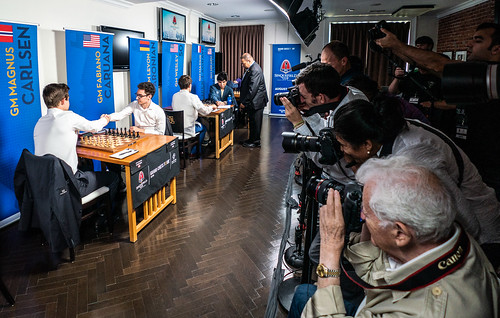 Photo by Lennart Ootes
Photo by Lennart Ootes
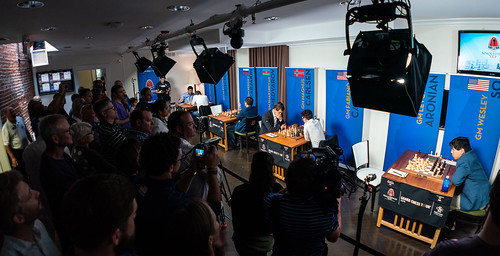 Photo by Lennart Ootes
The game itself saw Fabiano on the ropes, which led to Magnus visiting the Confession Booth to send one of the most talked about messages to the Fabiano fans in the US.
However, it all backfired as Fabiano managed to hold on by the skin of his teeth leaving me to tweet the following.
Photo by Lennart Ootes
The game itself saw Fabiano on the ropes, which led to Magnus visiting the Confession Booth to send one of the most talked about messages to the Fabiano fans in the US.
However, it all backfired as Fabiano managed to hold on by the skin of his teeth leaving me to tweet the following.
Dammit, going to be hard to encourage him to use it again 😀 https://t.co/XPdPqJFg2T
— Chris Bird (@ChrisBirdIA) August 25, 2018
Grischuk’s Bird’s Opening
Round 8 led to one of the funniest moments of the event, at least in my eyes. Alexander (Sasha) Grischuk, notorious for getting into time trouble, showed up a couple of minutes late to his game for the 2nd day in a row. He comes running in all flustered, apologizes for being late, puts his bag down and then rattles off 1. f4! for his opening move (the ! is because he basically shouted the move, not because of the greatness of it). It’s not often that Bird’s Opening is employed in such a high level event but as it put his opponent, Wesley So, into a deep think my brain started turning over how to make the most of this opportunity. As luck would have it Lennart Ootes, DGT and photography guru, just happened to be kicking around with his camera and the plan quickly came together.So I says to Grischuk “Listen Sasha, if you’re late again tomorrow I’m going to make you play an opening that will make you think of me all day long…” #SinquefieldCup 📷@LennartOotes pic.twitter.com/8XS4MTh7cp
— Chris Bird (@ChrisBirdIA) August 26, 2018
No Playoff for Sinquefield Cup
As you most undoubtedly know by now, the 2018 Sinquefield Cup ended in a 3-way tie for 1st with Magnus Carlsen and Levon Aronian managing to catch Fabiano Caruana with wins in the final round. There was then supposed to be a 2 player playoff, with the 2 players determined by the following tie-breaks:- Head to head results
- Most victories
- Most victories with the black pieces
- Drawing of lots
Needless to say it seems I’m well on my way to being a good luck charm for these 3, which probably has its pros and cons!#SinquefieldCup Coincidence: I was Chief Arbiter in 2013, 2014 & 2015, won by @MagnusCarlsen, @FabianoCaruana and @LevAronian respectively. I missed 2016 & 2017 but came back this year & the same 3 guys who had won it under my watch before all shared 1st place this year!
— Chris Bird (@ChrisBirdIA) August 28, 2018
Boyd Reed, Deputy Arbiter
My Deputy Arbiter for the Sinquefield Cup was none other than US Chess Director of National Events, IA Boyd Reed. Boyd had been Chief Arbiter of the St. Louis Rapid and Blitz and was able to stay on the extra 2 weeks or so to do this event too. Unfortunately Boyd had quite the cold going on for the first few days and had to survive on some decent medications to get himself through the event. However, Boyd did have some of his own fun during the event, as can be testified by some of his tweets.Things I think about while waiting for the last result from #sinquefieldcup R2:
— Boyd Reed (@eastsideflyer93) August 19, 2018
Number of @wsop #mainevent champions I've seen in St. Louis this week: 2 (Dan Harrington & @FossilMan)
Total distance from both, in feet: 4
Total number of words spoken to both: 0
Today’s #SinquefieldCup lesson for aspiring arbiters: always verify a threefold repetition claim, even when 2 of the 3 highest rated players in the world agree on it. 🤦🏾♂️ #YouHadOneJob
— Boyd Reed (@eastsideflyer93) August 20, 2018
Two weird experiences after yesterday’s #SinquefieldCup round. (1) while leaving, I was stopped for an autograph (whiskey…tango…foxtrot?). (2) I discovered I had the “GM” title next to my name in the pamphlet I was asked to sign. #typo 🤷🏾♂️
— Boyd Reed (@eastsideflyer93) August 26, 2018
Last day of #SinquefieldCup (I hope). Between this, #STLRapidBlitz and #usopenchess, I’ve been on the road for five straight weeks, and sick for three of them. 🏡 🙏🏾 #noplayoffs
— Boyd Reed (@eastsideflyer93) August 27, 2018
Today's #SinquefieldCup arbiter LOLz…
— Boyd Reed (@eastsideflyer93) August 27, 2018
2:40pm: I move spectator from restricted area.
2:48pm: gent in red polo and khaki slacks steps into same area. I say nothing. Previous spectator says I'm unfair. Me: "YOU go tell Rex Sinquefield to move." #GoldenRule
Round Robin Seating Plan Challenge
You have 10 players all set to play a round robin tournament where everyone will play everyone else once. The standard 10-player Berger table will be used.
10 players:
Rd 1: 1-10, 2-9, 3-8, 4-7, 5-6.
Rd 2: 10-6, 7-5, 8-4, 9-3, 1-2.
Rd 3: 2-10, 3-1, 4-9, 5-8, 6-7.
Rd 4: 10-7, 8-6, 9-5, 1-4, 2-3.
Rd 5: 3-10, 4-2, 5-1, 6-9, 7-8.
Rd 6: 10-8, 9-7, 1-6, 2-5, 3-4.
Rd 7: 4-10, 5-3, 6-2, 7-1, 8-9.
Rd 8: 10-9, 1-8, 2-7, 3-6, 4-5.
Rd 9: 5-10, 6-4, 7-3, 8-2, 9-1.
Here’s the challenge: There are 10 seats available for the players to sit at, boards 1 through 5 and each board has white and black. Is there a way to have each player not sit in the same seat more than once?
Failing that, is there a way to have each player not sit at any of the tables more than twice, irrespective of color?
Each time I get to one of these 10-player round robins I always try to rotate the seating to ensure everyone maximum fairness throughout the event but I invariably get a player sitting at a table 3 times and so if there are any math geniuses out there who know a solution, I’d be happy to hear it.
Thank you!
New US Chess and FIDE Rules Effective January 1, 2018
US Chess Rules Changes
Here are the main US Chess rule changes for January 1, 2018. There were also a couple of other minor variations created to pairings options and some changes to TD certification rules. All changes since the 6th Edition of the US Chess Rulebook can be found at http://www.uschess.org/docs/gov/reports/RulebookChanges.pdf. 9D. Pawn Promotion. New wording makes the procedure of promoting a pawn clearer. Now the pawn is considered touched and must be promoted to the unreleased piece touching the promotion square. 10H. Piece touched off the board. Wording change to be consistent with rule 9D. Once the piece off the board touches the promotion square the pawn must be promoted to that piece. Here are the new rules in full, the emboldened part showing the new wording: 9D. Pawn Promotion. In the case of the legal promotion of a pawn, the move is determined with no possibility of change when the pawn has been removed from the chessboard and the player’s hand has released the new appropriate piece on the promotion square, and completed when that player presses the clock (5H). If the player has released the pawn on the last rank, the move is not yet determined, but the player no longer has the right to play the pawn to another square. The choice of piece is finalized when the piece has touched the square of promotion, regardless of whether the pawn has been physically touched or placed on the promotion square. Once a piece has touched the promotion square a pawn must be promoted to that piece on that square, provided that the move is legal. See also 8F6, Pawn promotion; and 10H, Piece touched off the board. 10H. Piece Touched Off the Board. There is no penalty for touching a piece that is off the board. A player who advances a pawn to the last rank and then touches a piece off the board is not obligated to promote the pawn to the piece touched until that piece touches the promotion square. See also 8F6, Pawn promotion; and 9D, Pawn promotion.FIDE Law Changes
Only a few adjustments were made to the FIDE Laws for January 1, 2018. These relate to the new illegal moves and 7.5.5 is a condensed version of 7.7 and 7.8, which no longer exist. This hopes to clear up what was a very confusing original write of the illegal moves situations. Also, the number of illegal moves in rapid and blitz has been changed to match that of the regular competition rules meaning it is no longer one illegal move loses. Here are the complete new rules. Information can also be found at http://rules.fide.com/. 7.5.3 If the player presses the clock without making a move, it shall be considered and penalized as if an illegal move. 7.5.4 If a player uses two hands to make a single move (for example in case of castling, capturing or promotion) and pressed the clock, it shall be considered and penalized as if an illegal move. 7.5.5 After the action taken under Article 7.5.1, 7.5.2, 7.5.3 or 7.5.4 for the first completed illegal move by a player, the arbiter shall give two minutes extra time to his opponent; for the second completed illegal move by the same player the arbiter shall declare the game lost by this player. However, the game is drawn if the position is such that the opponent cannot checkmate the player’s king by any possible series of legal moves. A.4.2 If the arbiter observes an action taken under Article 7.5.1, 7.5.2, 7.5.3 or 7.5.4, he shall act according to Article 7.5.5, provided the opponent has not made his next move. If the arbiter does not intervene, the opponent is entitled to claim a win, provided the opponent has not made his next move. If the opponent does not claim and the arbiter does not intervene, the illegal move shall stand and the game shall continue. Once the opponent has made his next move, an illegal move cannot be corrected unless this is agreed by the players without intervention of the arbiter.New FIDE Illegal Move Laws (July 1, 2017)
7.5.1 An illegal move is completed once the player has pressed his clock. If during a game it is found that an illegal move has been completed, the position immediately before the irregularity shall be reinstated. If the position immediately before the irregularity cannot be determined, the game shall continue from the last identifiable position prior to the irregularity. Articles 4.3 and 4.7 apply to the move replacing the illegal move. The game shall then continue from this reinstated position. 7.5.2 If the player has moved a pawn to the furthest distant rank, pressed the clock, but not replaced the pawn with a new piece, the move is illegal. The pawn shall be replaced by a queen of the same colour as the pawn. 7.5.3 After the action taken under Article 7.5.1 or 7.5.2, for the first completed illegal move by a player, the arbiter shall give two minutes extra time to his opponent; for the second completed illegal move by the same player the arbiter shall declare the game lost by this player. However, the game is drawn if the position is such that the opponent cannot checkmate the player’s king by any possible series of legal moves. 7.7.1 If a player uses two hands to make a single move (in case of castling, capturing or promotion), it shall be considered as an illegal move. 7.7.2 For the first violation of the rule 7.7.1, the arbiter shall give two minutes extra time to his opponent; for the second violation of the rule 7.7.1 by the same player the arbiter shall declare the game lost by this player. However, the game is drawn if the position is such that the opponent cannot checkmate the player’s king by any possible series of legal moves. 7.8.1. If the player presses the clock without making a move, it shall be considered as an illegal move. 7.8.2 For the first violation of the rule 7.8.1, the arbiter shall give two minutes extra time to his opponent; for the second violation of the rule 7.8.1 by the same player the arbiter shall declare the game lost by this player. However, the game is drawn if the position is such that the opponent cannot checkmate the player’s king by any possible series of legal moves.7.7 and 7.8 are new illegal moves giving us four ways in total that an illegal move can be made. As you can see, the penalty for the first illegal move is +2 minutes to the opponent and for the second illegal move it is loss of game. However, in unsupervised rapid and blitz games, it only takes one illegal move to lose the game! At first, after a literal reading of the new rules “for the second violation of the rule 7.7.1…”, I thought that 7.7.2 and 7.8.2 related to only the second occurrence of 7.7.1 and 7.8.1 specifically. However, the following interpretations produced by the FIDE Arbiters’ Commission, in cooperation with the FIDE Rules Commission regarding the new illegal move Laws were published clarifying that any two illegal move violations will lead to loss of game.
1. By the new laws of Chess four (4) illegal moves are now in effect, according to the articles: 7.5.1, 7.5.2, 7.7.1 and 7.8.1. 2. In Standard chess the player is forfeited in case he completes two (2) of ANY of the above illegal moves. 3. However when there are two (2) illegal moves in one move (i.e. illegal castling made by two hands, illegal promotion made by two hands and illegal capturing made by two hands), they count as one (1) illegal move and the player shall not be forfeited at once (in Standard chess). 4. The capturing of the King is illegal move and is penalized accordingly. 8. In case that a player presses the clock without making a move, as mentioned in the article 6.2.4, it is considered as an illegal move and it is penalized according to the article 7.5.3. and not according to the article 12.9 9. If a player makes a move with one hand and presses the clock with the other, it is not considered as an illegal move and it is penalized according to the article 12.9.Bring forward the St. Louis Rapid & Blitz 2017 event that I was Chief Arbiter of. This was the first time I had overseen an event using the new rules and that brought with it a few questions, which I hope to share with people here so they can utilize how things were going to be ruled upon if they came up. (Note I am going to assume the player is using his right hand for all moves and the left hand is the one not to be involved.) 1) Is it considered using two hands to move with the right hand and hit the clock with the left? As pointed out in #9 of the interpretations this is not considered an illegal move and a player is penalized according to article 12.9. 2) When promoting a pawn, is it illegal to get the promotion piece from the side of the board with the left hand, pass the piece to the right hand and then use the right hand to place the piece on the queening square? So long as the same hand is used to move the pawn and place the promotion piece onto the board then no, this is not an illegal move. The promotion piece is not in play until it is placed on the square of promotion. 3) Is it illegal to make a capture with the right hand and pass the captured piece to the left hand to be placed with the other captured pieces? So long as only one hand is used to move your own piece and capture the opponent’s piece then no, this is not an illegal move. Once the captured piece has been removed from the board using one hand, that piece is no longer in play and can be moved to the captured piece pile using any hand. 4) A player castles using two hands, he uses his right hand to move his king and his left hand to move the rook. However, before hitting his clock, he puts the pieces back on their original squares and then proceeds to castle with one hand. Is this an illegal move? So long as the player puts the pieces back on their original squares and follows the Laws correctly, using only one hand this time, then no, this is not an illegal move. Remember that a player must hit the clock to complete the move before it becomes illegal. Also, even though two hands was used in the entire process of castling, uncastling and then castling again, the intent of the Law is to stop players gaining time by using two hands and so by resetting the position and performing the move correctly, no advantage has been gained. However, one very important point is if the arbiter is able to state with certainty that the rook was picked up first then touch move will be in effect on the rook! 5) An opponent makes a move with one hand but displaces pieces and still presses the clock. The player presses the clock back without making a move. Is this an illegal move? No, Law 7.4.1 say “If a player displaces one or more pieces, he shall re-establish the correct position in his own time.” In this case the player is utilizing this Law to make the player reinstate the displaced pieced in his own time. Of course this can sometimes cause confusion but either player also has the right to stop the clock to seek arbiter assistance. If the arbiter wishes to penalize the player who displaced the pieces he should use Law 12.9. Hopefully this has covered a few of the nuances with the new illegal move Laws but I’m sure there are folks out there who can come up with much more interesting questions than I did. I’m not the final decision maker when it comes to interpretations of the new Laws but if you have any questions please feel free to ask in the comments section.


























